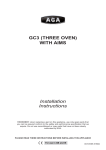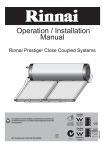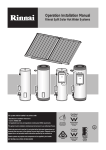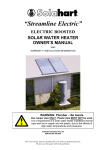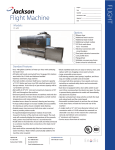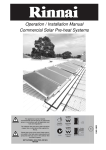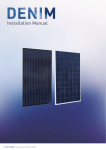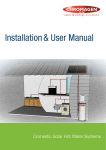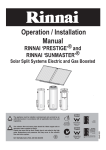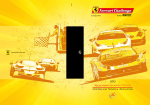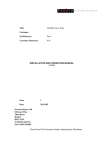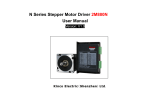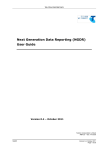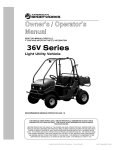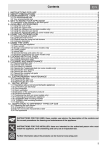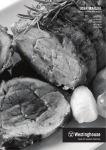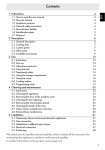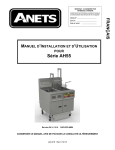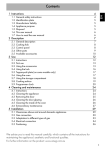Download Operation Installation Manual Close Coupled
Transcript
Operation Installation Manual Close Coupled Solar Hot Water Systems This system shall be installed in accordance with: • Manufacturer’s Installation Instructions • Current AS/NZS 3500 • All applicable local rules and regulations including local OH&S requirements This system must be installed, commissioned and serviced by an Authorised Person. All Rinnai gas products are A.G.A. certified. W169 SAI Global Issue 9 Plastic pipe must not be used as it is not suited to the high water temperatures and pressures that may occur in the collector flow and return system. Pipework must be copper tube or an equivalent metallic alternative specified by the manufacturer. Certain systems may require some components to be supplied by the installer NOT SUITABLE AS A POOL OR SPA HEATER AS 2712 Lic No.1849 SAI Global Table of Contents Models covered by Manual 4 Installation Record 4 Warnings and Important Information 5 Safety and Regulatory Information ��������������������������������������������������������������������������������������������������������������������� 5 Scald Hazards ���������������������������������������������������������������������������������������������������������������������������������������������������� 6 Operation Principle ��������������������������������������������������������������������������������������������������������������������������������������������� 7 Safety Devices ��������������������������������������������������������������������������������������������������������������������������������������������������� 8 Excessive Discharge from Safety Devices ��������������������������������������������������������������������������������������������������������� 8 Gas Boosters ������������������������������������������������������������������������������������������������������������������������������������������������������ 9 Hydrogen Gas ���������������������������������������������������������������������������������������������������������������������������������������������������� 9 Water Temperature ��������������������������������������������������������������������������������������������������������������������������������������������� 9 Turning Off the Water Heating System ��������������������������������������������������������������������������������������������������������������� 9 Turning On the Water Heating System ��������������������������������������������������������������������������������������������������������������� 9 Water Quality ���������������������������������������������������������������������������������������������������������������������������������������������������� 10 Draining and Filling the Water Heating System ������������������������������������������������������������������������������������������������ 10 Maintenance and Regular Care ����������������������������������������������������������������������������������������������������������������������� 10 Servicing and Repair ���������������������������������������������������������������������������������������������������������������������������������������� 10 Save a Service Call 11 Specifications 13 General ������������������������������������������������������������������������������������������������������������������������������������������������������������� 13 Cylinder Weights ���������������������������������������������������������������������������������������������������������������������������������������������� 13 System Dimensions - Stainless Steel Cylinders ����������������������������������������������������������������������������������������������� 14 System Dimensions - Glass Lined Cylinders ��������������������������������������������������������������������������������������������������� 15 Solar Collectors ������������������������������������������������������������������������������������������������������������������������������������������������ 16 Gas Boosters ���������������������������������������������������������������������������������������������������������������������������������������������������� 17 Installation - All Systems 18 Regulations and Occupation Health and Safety (OH&S) �������������������������������������������������������������������������������� 18 Location ����������������������������������������������������������������������������������������������������������������������������������������������������������� 18 Water Pipes ������������������������������������������������������������������������������������������������������������������������������������������������������ 18 Hot Water Delivery Temperature ���������������������������������������������������������������������������������������������������������������������� 19 Valves and Fittings ������������������������������������������������������������������������������������������������������������������������������������������� 20 System Orientation and Inclination ������������������������������������������������������������������������������������������������������������������� 21 Roof Mounting Options ������������������������������������������������������������������������������������������������������������������������������������� 22 Standard Installation ����������������������������������������������������������������������������������������������������������������������������������������� 23 Roof pitch greater than 30° ������������������������������������������������������������������������������������������������������������������������������ 28 Framed Installations - Flat, Reverse and Side Pitch ���������������������������������������������������������������������������������������� 29 Framed Installations - Cyclone Frame ������������������������������������������������������������������������������������������������������������� 29 180 Litre Stainless Steel Cylinder with 1 Collector - IKS180CCT01C �������������������������������������������������������������� 30 180 Litre Stainless Steel Cylinder with 2 Collectors - IKSUNICCT23C ������������������������������������������������������������ 32 330 Litre Stainless Steel Cylinder with 2 Collectors - IKS330CCT02C ������������������������������������������������������������ 34 Rinnai 2 CC Solar Operation and Installation Manual Table of Contents 330 Litre Stainless Steel Cylinder with 3 Collectors - IKSUNICCT23C ������������������������������������������������������������ 36 200 Litre Glass Lined Cylinder with 1 Collector - IKV200CCT01C ������������������������������������������������������������������� 38 200 Litre Glass Lined Cylinder with 2 Collectors - IKVUNICCT23C ����������������������������������������������������������������� 40 330 Litre Glass Lined Cylinder with 2 Collectors - IKV330CCT02C ����������������������������������������������������������������� 42 330 Litre Glass Lined Cylinder with 3 Collectors - IKVUNICCT23C ����������������������������������������������������������������� 44 Installation - Gas Boosted Systems 46 Gas Booster Location ��������������������������������������������������������������������������������������������������������������������������������������� 46 Gas Supply ������������������������������������������������������������������������������������������������������������������������������������������������������� 46 Hot Water Delivery Temperature ���������������������������������������������������������������������������������������������������������������������� 46 SMARTSTART® ����������������������������������������������������������������������������������������������������������������������������������������������� 46 System Using Rinnai SmartStart ���������������������������������������������������������������������������������������������������������������������� 47 Gas Booster Clearances ���������������������������������������������������������������������������������������������������������������������������������� 48 Installation Procedure ��������������������������������������������������������������������������������������������������������������������������������������� 49 Filling the System ��������������������������������������������������������������������������������������������������������������������������������������������� 50 Pre Solar Heating Checks �������������������������������������������������������������������������������������������������������������������������������� 50 Solar Heating ���������������������������������������������������������������������������������������������������������������������������������������������������� 51 Finishing the Installation ����������������������������������������������������������������������������������������������������������������������������������� 51 Draining Instructions ����������������������������������������������������������������������������������������������������������������������������������������� 51 Installation - Electric Boosted Systems 52 Installation Procedure ��������������������������������������������������������������������������������������������������������������������������������������� 52 Filling the System ��������������������������������������������������������������������������������������������������������������������������������������������� 53 Pre Solar Heating Checks �������������������������������������������������������������������������������������������������������������������������������� 53 Solar Heating ���������������������������������������������������������������������������������������������������������������������������������������������������� 54 Finishing the Installation ����������������������������������������������������������������������������������������������������������������������������������� 54 Draining Instructions ����������������������������������������������������������������������������������������������������������������������������������������� 54 Rinnai 3 CC Solar Operation and Installation Manual Models covered by Manual • Rinnai ‘Prestige’ ® Stainless Steel Close Coupled Solar Hot Water Systems; • Rinnai ‘Sunmaster’ ® Glass Lined, Close Coupled Solar Hot Water Systems; and • ‘Equinox’ ® Stainless Steel and Glass Lined, Close Coupled Solar Hot Water Systems. Installation Record Installer Details Installers Name: _______________________________________________________________________ Company Name: _______________________________________________________________________ Company Address: ________________________________________________________________________ _______________________________________________________________________ ________________________________________________________________________ Company Contact Details Telephone: ________________________________________________________________________ Mobile Phone: ________________________________________________________________________ Certificate of Compliance / Certification Number: Authorised Persons - Licence Number: _____________________________________________ ___________________________________________________ Installers Signature: _______________________________________________________________________ Installation Date: _______________________________________________________________________ System Details Storage Cylinder Model Number : __________________________________________________________ Serial Number: __________________________________________________________ Solar Collector(s) Model Number : __________________________________________________________ Serial Number: __________________________________________________________ Gas Booster Model Number : __________________________________________________________ Serial Number: __________________________________________________________ Installation Address: ________________________________________________________________________ _______________________________________________________________________ ________________________________________________________________________ Rinnai 4 CC OIM Issue 9 Warnings and Important Information Warnings and Important Information Safety and Regulatory Information DO NOT operate this system before reading the manufacturers instructions. WARNING This appliance must be installed, commissioned and serviced by an authorised person in accordance with all applicable local rules and regulations. Access covers of water heating system components will expose 240V wiring and MUST be removed by an authorised person. This appliance is not intended for use by persons (including children) with reduced physical, sensory or mental capabilities, or lack of experience and knowledge, unless they have been given supervision or instruction concerning use of the appliance by a person responsible for their safety. For continued safety of this appliance it must be installed, operated and maintained in accordance with the manufacturer’s instructions. Children should be supervised to ensure they DO NOT play with the appliance. Any power leads from the water heater system components MUST BE plugged into an external weatherproof electrical outlet. If the power supply cord of any water heating components is damaged, it MUST BE replaced by an authorised person in order to avoid a hazard, using genuine replacement parts available from Rinnai. Take care not to touch the power plugs with wet hands. Care should be taken not to touch the pipe work as it may be HOT! The pipes between the solar collectors and storage cylinder MUST BE copper or an equivalent metallic material specified by Rinnai. Plastic pipe is NOT suited to the water temperatures and pressures that may occur in the system. DO NOT place articles on or against this appliance. DO NOT store chemicals or flammable materials near this appliance. DO NOT operate with collectors or covers removed from this appliance. NEVER use a flammable spray such as hair spray, lacquer, paint, etc near this unit as this may cause a fire. NOTICE TO VICTORIAN CONSUMERS This appliance must be installed by a person licensed with the Plumbing Industry Commission. Only a licensed person will have insurance protecting their workmanship. So make sure you use a licensed person to install this appliance and ask for your Compliance Certificate. For Further information contact the Plumbing Industry Commission on 1800 015 129. Rinnai 5 CC OIM Issue 9 Warnings and Important Information Scald Hazards HOT WATER CAN CAUSE SCALDS. CHILDREN, DISABLED, ELDERLY AND THE INFIRM ARE AT THE HIGHEST RISK OF BEING SCALDED. FEEL WATER TEMPERATURE BEFORE BATHING OR SHOWERING. SCALDS FROM HOT WATER TAPS CAN RESULT IN SEVERE INJURIES TO YOUNG CHILDREN. SCALDS OCCUR WHEN CHILDREN ARE EXPOSED DIRECTLY TO HOT WATER WHEN THEY ARE PLACED INTO A BATH WHICH IS TOO HOT. ALWAYS...... Test the temperature of the water with your elbow before placing your child in the bath, also carefully feel water before bathing or showering yourself. Supervise children whenever they are in the bathroom. Make sure that the hot water tap is turned off tightly. CONSIDER..... NEVER…. Leave a toddler in the care of another child. They may not understand the need to have the water temperature set at a safe level. Rinnai 6 CC OIM Issue 9 Warnings and Important Information Operation Principle Close coupled systems are designed to have the solar collectors on the roof and the storage cylinder above the collectors, all mounted using available mounting brackets. Electric and gas boosted models are available. The system comprises of a hot water storage cylinder and solar collectors. Close coupled solar systems use the thermo-syphon principle to circulate the water through the collectors and then to the storage cylinder without the need for a pump. Supplementary heating is provided if insufficient heat is available from sun (such as during cloudy or rainy weather or during winter months) either via an electric heating element located inside the storage cylinder or via a gas booster located external to the storage cylinder. The following diagrams illustrates the Close Coupled Solar Hot Water Systems set up for electric and gas boosting. STORAGE CYLINDER STORAGE CYLINDER COLLECTORS COLLECTORS COLD WATER SUPPLY HOT WATER DELIVERY COLD WATER SUPPLY GAS BOOSTER HOT WATER DELIVERY GAS SUPPLY Glass Lined Gas Boosted Solar Hot Water System Glass Lined Electric Solar Hot Water System STORAGE CYLINDER STORAGE CYLINDER COLLECTORS COLD WATER SUPPLY HOT WATER DELIVERY COLLECTORS COLD WATER SUPPLY GAS BOOSTER GAS SUPPLY Stainless Steel Gas Boosted Solar Hot Water System Rinnai HOT WATER DELIVERY Stainless Steel Electric Solar Hot Water System 7 CC OIM Issue 9 Warnings and Important Information Safety Devices The water heating system is supplied with various safety devices including temperature sensors, overheat sensors and switches and a Pressure & Temperature Relief (PTR) valve. These devices must not be tampered with or removed. The water heating system must not be operated unless each of these devices is fitted and is in working order. DO NOT tamper with or remove safety devices. WARNING DO NOT operate the water heater unless all safety devices are fitted and in working order. DO NOT block or seal the PTR Valve and drain pipe. Pressure & Temperature Relief (PTR) Valve This valve is located near the top of the water heater and is essential for safe operation. It is normal for the valve to release a small quantity of water through the drain line during heating. However, continuous leakage of water from the valve and its drain line may indicate a problem with the water heater. WARNING Tw ist cap until w ater flow s from drain line Lift lever until w ater flow s from drain line (Low er lever gently!) Never block the outlet of the PTR valve or it’s drain line for any reason. The easing gear must be operated at least every 6 months to remove lime deposits and verify that it is not blocked. Failure to do this may result in the water heater failing. If the valve does not discharge water when the easing gear lever is opened, or does not seal again when the easing gear is closed, attendance by an authorised person must be arranged without delay. The PTR valve is not serviceable. Excessive Discharge from Safety Devices Pressure & Temperature Relief (PTR) Valve It is normal and desirable that this valve allows a small quantity of water to be discharged during the heating cycle. If it discharges more than a bucket of water during a 24 hour period or discharges continuously there may be another problem. If the valve dribbles continuously, try easing the valve gear for a few seconds as described above. This may dislodge any foreign matter and alleviate the problem. If the valve discharges at high flows, especially at night, it may be as a result of the water pressure exceeding the design pressure of the water heater. Ask your installer to fit a Pressure Limiting Valve (PLV). WARNING NEVER replace the PTR valve with one which has a higher pressure rating than is specified for your water heater. Expansion Control Valve (ECV) - if fitted It is normal and desirable that this valve allows a small quantity of water to be discharged during the heating cycle. If it discharges more than a bucket of water during a 24 hour period or discharges continuously there may be another problem. If the valve leaks continuously, try easing the valve gear for a few seconds. This may dislodge any foreign matter and alleviate the problem. If this does not alleviate the problem contact Rinnai. Operate the easing gear regularly to remove any lime deposits and to verify that it is not blocked. Rinnai 8 CC OIM Issue 9 Warnings and Important Information Gas Boosters • • • • Do not touch the flue outlet or do not insert any objects into the flue outlet. Keep flammable materials, spray cans, fuel containers, trees, shrubs and pool chemicals etc, well clear of the flue outlet. Do not use the gas types other than those designated on the data plate. For example, do not use Propane/ Butane gas mixtures on appliances marked Propane Gas. Do not use Propane Gas on appliances marked as Natural Gas and vice versa. Hydrogen Gas In the case of systems using a vitreous enamel lined cylinder, if the hot water unit is not used for two weeks or more, a quantity of hydrogen gas, which is highly flammable, may accumulate in the water heater. To dissipate this safely, it is recommended that a non electrically operated hot tap be turned on for two minutes at a sink, basin, or bath, but not a dishwasher or other appliance. During this procedure there must be no smoking, open flame or any electrical appliance operating nearby. If hydrogen is discharged through the tap, it will probably make a sound like air escaping. Water Temperature The water gets heated by the solar energy contributed from the sun and heats the water until the water at the base of the storage cylinder reaches approximately 65°C. At this time water at the hot outlet can be up to 88°C. Continued heating is prevented by the ‘No Load’ protection, a Thermo-arrestor (TA) valve that prevents water passing from the cylinder to the collectors. During periods of low solar gain, supplementary heating occurs. IMPORTANT To meet Australian regulatory requirements, supplementary heating must be operational. Turning Off the Water Heating System If you plan to be away for only a few nights, we suggest you leave the water heating system switched on. If it is necessary to switch off the water heater, do so as outlined below: Electric Boosted Systems • Switch off the electrical supply to the supplementary heating element. The switch is usually marked and located in the electricity meter box of the dwelling. Gas Boosted systems • Switch off the electric supply to the gas booster. Turning On the Water Heating System Electric Boosted system • Switch on the electric supply to the supplementary heating element(s). The switch is usually marked and located in the electricity meter box of the dwelling. Gas Boosted systems • Rinnai Switch on the electrical supply to the gas booster. 9 CC OIM Issue 9 Warnings and Important Information Water Quality The water quality of most public supplies is suitable for the water heating system. The water quality from bore wells is generally unsuitable for the water heating system. Refer to the separate warranty document for water quality parameters and how they affect the warranty conditions. If in doubt about the water quality, have it checked against the parameters listed in the warranty document. The system is not suitable as a pool or spa heater. Draining and Filling the Water Heating System Draining or filling normally occur only during installation or servicing and must be carried out by an authorised person. Maintenance and Regular Care Operate the easing gear of the PTR as described in the section ‘Safety Devices’ on page 8. Servicing and Repair Our Servicing network personnel are fully trained and equipped to give the best service on your appliance. If your appliance needs service, ring one of the service contact numbers on the back of this booklet. It is recommended that the system be serviced at least every 5 years. The pressure and temperature relief valve and expansion control valve must be checked for performance or replaced by an authorised person at intervals not exceeding 5 years or more frequently in areas where the water is classified as scaling water (refer to the supplied warranty booklet). It is recommended that the sacrificial anode fitted to Glass Lined cylinders be inspected every 5 years or more frequently in areas where there is a high incidence of water deposits. This does not apply to Stainless Steel cylinders. Anodes suited to hard and soft water, are available from Rinnai. If the electric conduit, power supply cord or plug to the water heater is damaged, they must be replaced by an authorised person in order to avoid a hazard. The power supply cord and plug (if fitted) must be replaced by a genuine replacement part available from Rinnai. Rinnai10 CC OIM Issue 9 Save a Service Call Before contacting Rinnai for service, please follow the fault finding guide. If the problem persists or this information doesn’t answer your questions, contact Rinnai on the phone number on the back of this manual Service call outs attending to any condition or fault that is not related to Rinnai product or components may be chargeable. INSUFFICIENT OR NO HOT WATER Excessive hot water consumption Electric Boosted Systems: Often people are surprised at the amount of hot water used, especially when showering. If the amount of hot water used during the day exceeds the storage capacity of the cylinder, it is likely that there will be insufficient hot water. Gas Boosted Systems: Insufficient flow may occur if multiple outlets are in use at the same time and exceed the rated flow capacity of the gas booster. If so, reduce the number of outlets in use. Consider discussing with your installer, fitting water saving fixtures and/or flow control or pressure limiting valves to reduce consumption. Incorrect solar system size The system may not have been adequately sized to suit the household. Temperature and pressure relief valve / expansion control valve discharging water continuously PTR Valves & ECV Valves (if fitted) It is normal and desirable that these valves allows a small quantity of water to be discharged during the heating cycle. If they discharges more than a standard bucket of water during a 24 hour period or discharges continuously there may be another problem If water continuously dribbles from the valve, try easing the valve gear for a few seconds as described in the section ‘Maintenance and Regular Care’ on page 10. This may dislodge any foreign matter and alleviate the problem. If the valve discharges at high flows, contact your installer or Rinnai to discuss. Booster heating not operating for electric systems Electric boosted Systems: Check to ensure the electric isolating switch(es) at the switchboard (usually marked “Hot water” or “water heater”) is switched ‘ON’. Check to ensure that the electric fuses for hot water at the switchboard are intact If running on Off-Peak, discuss boosting times with electricity supplier. Booster heating not operating or insufficient gas supply for gas boosted heating system Gas booster not operating or insufficient gas supply for gas boosted heating system Gas Boosted Systems: Check to ensure the power cord of the gas booster is plugged in and switched ‘on’. Check gas is available and the isolation valve is opened Close the hot tap and wait for 10 seconds and open it again. The hot tap must be opened enough to ensure that the flow rate is sufficient for the gas booster to light. Check if there is gas supply to other appliances in the rest of the house Booster thermostat settings Electric Boosted Systems: Check the temperature of hot water delivered with a thermometer placed under the closest outlet (usually the kitchen sink) on a non-tempered hot water line This test should be done early in the morning after overnight electrical boosting before any hot water is used. The temperature of the water delivered should be at least 55°C (allowing for heat losses in pipe work) If this is not the case or the temperature may need to be increased. Contact your installer or Rinnai to discuss adjusting the thermostat. NO WATER FROM THE HOT TAP Restriction in the hot tap or failure of the cold water supply to the heater Check for water flow at the other hot taps and that the cold water isolation valve is fully open Rinnai11 CC OIM Issue 9 Save a service call HIGH ELECTRICITY OR GAS BILL Hot water usage patterns Electric Boosted Systems: If using an off peak (overnight) boosted electrical system, the time of use of the water may affect whether heating is done by electric element or solar energy. This is because both solar heated water and electrically heated water are stored in the same cylinder. As the element is in the middle of the tank, half the tank can be heated each night by the booster element. If the bulk of hot water is used in the morning, there will be cold water in the cylinder for the sun to heat during the day leading to lower electricity usage. If the bulk of the hot water is used in the evening, the electric element will reheat the water overnight. In the morning there will only be half a cylinder of cold water for the sun to heat. Consider changing your usage pattern to optimise solar energy usage. High electricity cost Electric Boosted Systems: The electricity tariff will determine the running costs of the system. Contact the electricity supplier to confirm what these tariffs are. Temperature and pressure relief valve / expansion control valve discharging water continuously See entry under ‘Insufficient or No Hot Water’ Lack of solar gain • Reduced sunlight due to overcast weather in summer or low solar contribution in winter will result in an increased dependence on electricity or gas boosting. Higher electricity or gas bills under these conditions, especially in winter, are normal. • If the solar collectors are shaded by trees or other objects, or the glass is dirty, the effectiveness of the collectors is greatly reduced. Arrange for trimming of the trees or relocation of the solar collectors if the obstruction is permanent. Arrange for cleaning of the collector glass • Solar collectors incorrectly positioned will also severely affect the solar gain. Check that positioning and alignment of solar collectors is in accordance with the section ‘System Orientation and Inclination’ on page 21. Condensation in Collectors Condensation in solar collectors There is a small amount of ventilation between atmosphere and the internals of the solar collector to ensure efficient operation. Under certain weather conditions, water vapour naturally present in the air may condense on the inside surface of the collector glass. This does not affect the performance of the system. If you are concerned contact Rinnai to discuss. NOISY SOLAR COLLECTORS Noise from solar collectors Occasionally on days of high solar gain, the water temperature in the collector may become very high. The noise may be similar to a boiling kettle, or an expanding contracting metallic sound. The collector is designed to withstand these conditions, and no action is needed, unless it is extreme. Contact Rinnai to discuss if you have any concerns. WATER HAMMER Hot and cold water plumbing in the premises Contact your installer or a plumber to discuss checking the clipping of hot and cold water pipe work and install a pressure limiting valve or water hammer arrestor as required Rinnai12 CC OIM Issue 9 Specifications General Close Coupled hot water systems are specified according to the cylinder capacity, number of solar collectors and boost type and capacity. Boost capacity for gas boosted system depends on the gas booster model selected. Boost capacity for electrically boosted systems depends on the power rating of the electric heating element. Specifications for the various components are shown below. Solar flow and return connection: Rp ¾ PTR valve connection: Rp ¾ Cold inlet connection: Rp ¾ Hot outlet connection: Rp ¾ PTR valve setting 850 kPa Rating of PTR Valve supplied 10 kW Expansion Control Valve (ECV) setting (suplied by installer if required) 700 kPa Max supply pressure with ECV 500 kPa Max supply pressure without ECV 700 kPa Pressure limiting valve rating (supplied by installer if required) 500 kPa Electric element power rating 2.4 or 3.6 kW standard 1.8 or 4.8 kW available for stainless steel cylinders 4.8 kW available for glass lined cylinders Cylinder Weights Mass of Cylinder (empty) Mass of Cylinder (filled) Stainless steel 180 litre 40 kg 225 kg Stainless steel 330 litre 80 kg 412 kg Glass lined 200 litre 77 kg 277 kg Glass lined 330 litre 104 kg 434 kg Rinnai13 CC OIM Issue 9 Specifications System Dimensions - Stainless Steel Cylinders 1555 2370 1200 1200 1025 (1050) 2120 (2165) 2465 2090 3495 2090 2120 (2165) 3215 (3290) 610 600 1940 (1965) 2535 (2560) Dimensions shown for Enduro Collectors Dimensions in brackets “(__)” for Excelsior Collectors Rinnai14 CC OIM Issue 9 Specifications System Dimensions - Glass Lined Cylinders 1415 2280 1140 1140 2120 (2170) 1025 (1050) 2250 3380 1735 1735 3215 (3290) 2120 (2170) 685 695 Dimensions shown for Enduro Collectors 1940 (1965) Dimensions in brackets “(___)” for Excelsior Collectors 2605 (2605) Rinnai15 CC OIM Issue 9 Specifications Solar Collectors Type Waterways Absorber Selective Surface ENDURO - SP200A or SP200A FTC EXCELSIOR - EXT or EXT FTC Flat plate Flat plate Copper Copper Aluminium Copper High Performance Sputtered Titanium Oxide Maximum Operating Pressure 850 kPa Casing Material Overall Dimensions (L x W x H) (mm) Weight empty (STD/FTC) (kg). Water volume (litres) Aluminium 1940 x 1025 x 80 1964 x 1047 x 81 33 / 35 35 / 38 1.3 1.5 Number risers Potential Solar Output at PTR relief conditions (kW) Frost Protection 1.25 kW Standard version - no frost protection FTC Version - Frost Protection to -5°C FOR MORE INFORMATION ON FROST PROTECTION REFER TO WARRANTY BOOKLET Rinnai16 CC OIM Issue 9 Specifications Gas Boosters Model Name S20 S26 S26i * S32 * Boost capacity at 20°C rise (l/min) 20 26 32 37 Boost capacity at 25°C rise (l/min) 16 24 26 32 Maximum rated flow (l/min) 20 26 32 37 Minimum water supply pressure for maximum rated flow (kPa) 1 120 200 140 180 Frost protection Yes Gas consumption maximum (MJ/h) 125 188 195 250 Gas consumption minimum (MJ/h) 18 23 16 21 70 Hot water delivery temperature (°C) 2 Dimensions - height x width x depth (mm) Weight (kg) 600 x 470 x 244 530 x 350 x 194 15 21 21 29 1 Units will operate at lower pressures but the rated flow will not be achieved. 2 Gas boosters for Solar hot water applications must be set by Rinnai to deliver a minimum temperature of 70°C. Solar Gas boosters will be marked as Solar. Units not marked ‘Solar’ MUST NOT be used, and will invalidate warranty. See warranty booklet for more details. * These models are made to order. Rinnai17 CC OIM Issue 9 Installation - All Systems Regulations and Occupation Health and Safety (OH&S) Installation and commissioning must be performed by authorised persons. WARNING Solar systems must be installed in accordance with these instructions and all regulatory requirements which exist in your area including those in relation to manual lifting, working at heights and on roofs. Applicable publications and regulations may include: • • • • • AS/NZS 5601 Gas Installations AS/NZS 3500 National Plumbing and Drainage AS/NZS 3000 Wiring rules Building Codes of Australia (BCA) Local Occupational Health and Safety (OH&S) regulations This appliance is not suitable for use as a domestic spa pool or swimming pool heater. Solar collectors and cylinders are heavy and bulky items and are usually positioned on the roofs of buildings. Australian State and Territories have a principal Occupational Health and Safety (OH&S) Act which contains requirements relating to the handling of large, bulky or awkward items and the prevention of falls from elevated surfaces. Persons installing solar collectors must be aware of their responsibilities and be adequately trained and qualified, in accordance with local OH&S requirements. Location System Location WARNING These systems are only suitable for use on buildings up to 10 metres tall. Select suitable areas of roof on which to install the solar collectors and cylinder. It is essential that the roof structure is suitable for the solar collector/cylinder combination and can support the weight of these items when full of water. It is the installers responsibility to ensure the roof can safely support the system and to visually check the roof, and if there is any damage that requires attention (such as cracked tiles etc.), to inform the owner. If this affects the safe installation of any part of the system, installation should not proceed until the damage has been rectified. Collectors should be positioned for optimum solar benefit. Refer to the section ‘System Orientation and Inclination’ on page 21 for more information. All system components must be in an accessible location. Sufficient clearances shall allow access to, and removal of, all serviceable parts. Ensure the PTR valve, drain lines, thermostats and elements have sufficient clearances and are accessible for service and removal. The information on any data plates must also be readable. All electrically boosted solar hot water heating elements must be connected to an independent, fused, AC 240V 50 Hz power supply with an isolating switch installed at the switch board. Gas Booster Location (where applicable) The S20, S26 and S32 gas boosters are designed for ‘Outdoor’ Installation only. As such, they must be located in an above ground open air situation with natural ventilation, without stagnant areas, where gas leakage & products of combustion are rapidly dispersed by wind and natural convection. If an internal model which has been converted to a solar gas booster follow information supplied with the unit for location, mounting and flueing requirements. Water Pipes All hot water pipework should be insulated with sealed Polyethylene foamed or equivalent insulation to optimise performance and energy efficiency. Such insulation may also be mandatory under local regulations. Rinnai recommend insulation to achieve an R value of 0.6 K.m2/W or higher depending on location. With the exception of solar collector flow and return pipes, water pipe sizing should be performed in accordance with AS/NZS 3500. All external pipework MUST be insulated to prevent frost damage. Rinnai18 CC OIM Issue 9 Installation - All Systems The collector flow and return pipes must be copper tube or alternative material pipe supplied by Rinnai. WARNING Plastic pipe must not be used between collectors and cylinder or booster, as it is not suited to the high water temperatures and pressures that may occur. Pipework must be copper tube or an equivalent metallic alternative specified by the manufacturer Water Supply The maximum water pressures for the various systems are listed on page 13. Approved pressure limiting valves may be required if the ‘Maximum’ rated water supply pressures are exceeded. For gas boosted systems to achieve the rated flow through the outlet of the continuous flow water heater, the minimum water supply pressures must be supplied. The systems will operate at lower pressures but the rated flow will not be achieved. Water chemistry and impurity limits are detailed in the separate warranty booklet. Most metropolitan water supplies fall within these requirements. If you are unsure about water quality, contact your water authority. If sludge or foreign matter is present in the water supply, a suitable filter should be incorporated in the water supply to the storage cylinder. Hot Water Delivery Temperature Local regulations and/or the requirements of AS/NZS 3500.4 must be considered regarding the temperature limitations of hot water supplied to areas used primarily for personal hygiene. The temperature of water to these areas is limited to 45°C for early childhood centres, primary and secondary schools and nursing homes or similar facilities for young, aged, sick or people with disabilities and 50°C for all other buildings. To comply with these requirements, a temperature limiting device, such as a thermostatic mixing or tempering valve, will be required on all solar hot water systems as detailed below. COLD WATER SUPPLY LAUNDRY HEATED WATER FROM STORAGE CYLINDER GAS SUPPLY KITCHEN BATHROOM ENSUITE TEMPERATURE LIMITING DEVICE Tempered Gas Hot Water System LAUNDRY COLD WATER SUPPLY HEATED WATER FROM STORAGE CYLINDER KITCHEN BATHROOM ENSUITE TEMPERATURE LIMITING DEVICE Tempered Electric Hot Water System Rinnai19 CC OIM Issue 9 Installation - All Systems Valves and Fittings The following valves and fittings are supplied with your solar hot water system: • • • • A combined pressure and temperature (PTR) relief valve, capacity 10 kW. Relief valve pressure settings vary with models. This valve is fitted at the top of the storage cylinder. The PTR valve is a safety device and it is mandatory that it is fitted by the installer in all installations. Thermo-Arrestor (TA) valve. This valve is fitted on the inlet pipe to the Solar Collectors. For gas boosted systems, elbow connections for the hot, cold and gas supply are fitted at the bottom of the gas booster. Fittings as shown on pages 30 to 45 The following valves & fittings are to be supplied by the installer: • • • • • A cold water expansion control valve (ECV). An ECV must be fitted in Western Australia and South Australia to the cold water supply to the storage cylinder to comply with local regulations. An ECV is recommended in all other geographical areas where the water supply has a tendency to cause scaling. This will reduce hot water discharge from the pressure and temperature relief (PTR) valve which minimises wear on this valve. A stop cock, non return valve and line strainer. Combination valves incorporating two or more of these functions (such as ‘Trio’ valves) are suitable. These are fitted to the cold water supply to the storage cylinder by the installer. Cold water supply and hot water discharge pipework to and from the storage cylinder. An isolating valve and connection union for the gas supply to the gas booster. An approved pressure limiting valve (supplied with some systems) is required if the maximum rated water supply pressure on page 13 is exceeded. Rinnai20 CC OIM Issue 9 Installation - All Systems System Orientation and Inclination IMPORTANT Installers must ensure they comply with relevant local regulations in regards to inclination and orientation. The performance of any solar hot water system is determined by the way that the system is installed. In Australia, the solar collectors ideally should face the equator (North) as shown below. Where this orientation is not practical, collectors facing within 45 degrees from North (between North-East and North-West) are acceptable and will only reduce efficiency by approximately 5%. The inclination of the solar collectors should ideally be the same as the latitude angle of the site. Inclinations within 20 degrees of the latitude angle of the site will only reduce efficiency by approximately 5%. Most roofs within Australia have a slope of between 20° and 25° and provide an appropriately angled mounting surface. To ensure operation of the system the installation must not be less than 10°. Orientation and inclination of collectors City Latitude City Latitude City Latitude Adelaide 35°S Canberra 35°S Melbourne 38°S Albany 35°S Darwin 12°S Perth 32°S Alice Springs 24°S Dubbo 32°S Port Hedland 20°S Brisbane 27°S Geraldton 28°S Rockhampton 24°S Broken Hill 31°S Hobart 42°S Sydney 34°S Cairns 17°S Mildura Townsville 19°S 34°S Latitudes of Australian Cities Rinnai21 CC OIM Issue 9 Installation - All Systems Roof Mounting Options These systems are not suitable for use on roofs over 10 m high. WARNING For roofs with a slope of 10° or less a flat roof frame must be used. Rinnai do not recommend installing Close Coupled systems on roofs with a pitch greater than 30°. An additional strap should be used to prevent the cylinder from tipping over if a system is installed in this manner. Refer page 28. It is normal to mount the solar collectors down close to the gutter. Roof construction must be checked to ensure that the roof timbers are capable of supporting the additional load. (Refer to AS 3500.4 Appendix H). For tiled roof installations. Check for cracked or damaged tiles in the area of proposed installation. Replace any faulty tiles. If spare tiles are not available, swap damaged tiles with good ones from along the gutter line. Standard Installation Installation details are in this manual. N Flat Roof Frame Additional information is provided in the roof frame manual provided with the frame. N Reverse Pitch Frame Additional information is provided in the roof frame manual provided with the frame. N Side Pitch Frame Additional information is provided in the roof frame manual provided with the frame. N Cyclone Frame Additional Information is provided in the Cyclone frame manual provided with the cyclone frame N Rinnai22 CC OIM Issue 9 Installation - All Systems Standard Installation This type of installation is not suitable for use on roofs over 10 m high. WARNING This type of installation is not suitable for use in cyclonic areas. Collector Rail Pre Assembly Assemble the collector rail components as shown. Only loosely attach the collector retainers to the rails. Details of component quantities are shown in the tables on page 30 to 45. COLLECTOR SUPPORT STRAPS MOUNTING RAIL COLLECTOR RETAINERS M6 BOLT, NUT &WASHER COLLECTOR SUPPORT STRAPS MOUNTING RAIL COLLECTOR RETAINERS M6 BOLT, NUT &WASHER Rinnai23 CC OIM Issue 9 Installation - All Systems Fastening Collectors to a Tiled Roof This type of installation is not suitable for use on roofs over 10 m high. WARNING This type of installation is not suitable for use in cyclonic areas. Attach the collector mounting straps to the rafter or truss under the tiles. Tiles removed Nail strap to rafter Place the collector(s) onto the roof above the lower rail. If more than one collector is being installed then join them together using the compression fittings supplied. Push down on the collector retainers to clamp the collector and tighten the nuts. Position the upper collector rail above the collectors. Push down on the retainers to clamp the collector and tighten the nuts. Attach the collector mounting straps to the rafter or truss under the tiles. Tiles removed Nail strap to rafter Replace the tiles and ensure the collector is secure. Rinnai24 CC OIM Issue 9 Installation - All Systems Fastening Collectors to a Metal Roof This type of installation is not suitable for use on roofs over 10 m high. WARNING This type of installation is not suitable for use in cyclonic areas. Position the lower collector mounting rail assembly so that the rail is over the roof purlin. Drill through the roof iron and purlin using the holes in the rail as a guide. Apply some silicone sealant down the holes to ensure no water leakage. Bolt the rail to the roof purlin using a suitable fastener. Position the collector(s) onto the roof above the lower rail. If more than one collector is being installed, join them together using the compression fittings supplied. Push down on the collector retainers to clamp the collector and tighten the nuts. Place the upper collector mounting rail above the collectors. Push down on the collector retainers to clamp the collector and tighten the nuts. Drill through the roof iron and purlin using the upper mounting rail as a guide. Apply some silicone sealant down the holes to ensure no water leakage and secure with suitable fasteners. Alternatively the rail can be attached to the roof using the collector mounting straps. Rinnai25 CC OIM Issue 9 Installation - All Systems Attaching mounting rail to cylinder on stainless steel cylinders Depending on the packaging, either one or two rails are attached to the cylinder. The extra rail and fastenings are packed with the cylinder. They are screwed into the rail mounting holes in the cylinder. Attach the rail using the bolts, washers and spring washers in the order shown. Ensure the feet on the rails face outwards Rail Washer Bolt Ensure that the bolt is tightened sufficiently to flatten the spring washer. This ensures that the bolt is adequately tightened. Spring Washer Once the rail is attached and suitably tightened, continue the cylinder installation as shown on the next page. Rinnai26 CC OIM Issue 9 Installation - All Systems Fastening Cylinder to Roof Lift the storage cylinder onto the roof and locate it above the collector bank. The cylinder’s position should be as central as possible to the collector bank. The lower rail must be on a load bearing surface. Slide the cylinder support strap into the slots located in the uppermost cylinder support bracket so that the strap is in line with a suitable fastening position Tiled Roof Remove tiles one row up from the storage cylinder. Apply tension to the straps and attach them to the rafters using a suitable fastener. TILE REMOVED Replace the tiles LOWER CYLINDER RAIL MUST BE ON A LOAD BEARING SURFACE FASTEN STRAP TO RAFTER Metal Roof BOLT STRAP TO ROOF USING A SUITABLE FASTENER Bolt the lower support rail to the roof using a suitable fastener. BOLT RAIL TO ROOF USING A SUITABLE FASTENER Apply tension to the cylinder support straps and attach them to the rafters using a suitable fastener. Seal any holes in roof using a suitable sealant to ensure roof is water tight. Rinnai27 LOWER CYLINDER RAIL MUST BE ON A LOAD BEARING SURFACE CC OIM Issue 9 Installation - All Systems Roof pitch greater than 30° In situations where a Close Coupled System is installed onto a roof with a pitch of 30° or greater, an additional strap must be used to prevent the cylinder tipping over. Builders strapping available from hardware stores is suitable for this. The strapping is attached through the slots in the front cylinder rail, goes over the tank and is then fastened to the roof behind the cylinder. Tiled Roof Metal Roof Securely fasten strap to roof using a suitable fastener Securely fasten strap to roof using a suitable fastener Attach strap through slot in cylinder rail. Attach straps through slot in cylinder rail. Ensure straps are on main section of tank as plastic endcaps are not loadbearing Securely fasten straps to roof using a suitable fastener Ensure straps are on main section of tank as plastic endcaps are not loadbearing Securely fasten strap using a suitable fastener Rinnai28 CC OIM Issue 9 Installation - All Systems Framed Installations - Flat, Reverse and Side Pitch This type of installation is not suitable for use on roofs over 10 m high. WARNING This type of installation is not suitable for use in cyclonic areas. Flat Roof Frame For use on a flat roof or where the roof pitch is too low. This frame allows the system to be installed at a suitable inclination. Installations instructions are provided in the Rinnai Frame Installation Manual. A Glass Lined 330 litre tank with 3 collectors CANNOT be installed on a flat roof frame Reverse Pitch Frame These comprise of a Close Coupled system flat roof frame and a side/reverse pitch kit. They can be used when the system need to be installed in the reverse direction to the direction the roof is facing. For example, using a reverse pitch frame on a South facing roof enables the system to be oriented to the North. Installations instructions are provided in the Rinnai Frame Installation Manual. A 330 litre tank with 3 collectors CANNOT be installed on a reverse pitch roof frame Side Pitch Frame These comprise of a Close Coupled system flat roof frame and a side/reverse pitch kit. They can be used when the system need to be installed side on to the direction the roof is facing. For example, using a side pitch frame on an East or West facing roof to enables the system to be oriented to the North. Installations instructions are provided in the Rinnai Frame Installation Manual. A 330 litre tank with 3 collectors CANNOT be installed on a side pitch roof frame Framed Installations - Cyclone Frame Assemble cyclone frame and mount components as described in instructions provide with cyclone frame kit. Rinnai29 CC OIM Issue 9 Installation - All Systems Rinnai30 10 12 21 11 9 8 22 6 5 1 2 12 21 23 22 24 180 Litre Stainless Steel Cylinder with 1 Collector - IKS180CCT01C CC OIM Issue 9 1 1 1 1 1 1 1 2 5 6 8 9 Qty Rinnai31 Rp ¾ x G ¾ (Kinco) Elbow assembly M33 x R ¾ Adaptor TA Valve R1 x R ¾ Reducing Nipple *supplied with cylinder T adaptor hot outlet *supplied with cylinder P&TR Valve Item/PartNumber Elbow 21201026 Kinco Nut 16801018 Kinco Olive 33001011 16601096 11007711 17201036 19001018 11004784 24 23 22 21 12 11 10 1 1 2 2 1 1 1 Qty Copper Pipe with Insulation - 1 x nipple G ¾ x R ¾ - 1 x Kinco nut and olive ¾ Union ¾ -compression to R Stop end assembly - 1 nipple G ¾ - 2 x Kinco nuts and olives ¾ Union Compression ¾ Copper Pipe 1765mm Copper Pipe - 1 x Elbow G ¾ (Kinco) x G ¾ (Kinco) - 2 x Kinco nuts and olives ¾ Elbow assembly Item/PartNumber 31601750 32201713 28801025 32201709 31601775 31601772 21201038 - - - - - 1 1 1 4 4 4 2 - - 4 2 - - Qty STC form Warranty Booklet 12401013 12401012 14201196 15401023 15401041 15401022 Bolt 22601073 Washer 17401073 Nut 16801007 26601706 Bolt 22601052 Washer 17401072 Nut 16801062 Operation and Installation Manual (used with collector retainers) M6 Bolt Washer and Nut Collector Retainer strap to mounting rail) M8 Bolt Washer and Nut (used to bolt collector mounting Cylinder Mounting Straps 2 with collector, 2 in kit Collector Mounting Straps Mounting Rail Small Item/PartNumber Installation - All Systems 180 Litre Stainless Steel Cylinder with 1 Collector - IKS180CCT01C CC OIM Issue 9 Installation - All Systems Rinnai32 10 16 22 21 9 15 10 2 1 8 6 5 36 21 17 21 23 30 16 22 21 21 25 180 Litre Stainless Steel Cylinder with 2 Collectors - IKSUNICCT23C CC OIM Issue 9 1 1 1 1 1 1 2 1 2 5 6 8 9 10 Qty Rinnai33 16601096 11007711 17201036 19001018 11004784 21201038 Elbow 21201026 Kinco Nut 16801018 Kinco Olive 3001011 - 1 x Elbow G ¾ (Kinco) x G ¾ (Kinco) - 2 x Kinco nuts and olives ¾ Elbow assembly Rp ¾ x G ¾ (Kinco) Elbow assembly M33 x R ¾ Adaptor TA Valve R1 x R ¾ Reducing Nipple *supplied with cylinder T adaptor hot outlet *supplied with cylinder P&TR Valve Item/PartNumber - 30 25 23 22 21 16 15 1 1 1 1 2 used 2 not 6 1 1 Qty (1 of each not used) - 3 x insulation, 3 x foil tape Collector Joining Insulation (540 long - installer to cut to approx 437) Copper Pipe with Insulation Copper Pipe with Insulation - 1 x nipple G ¾ x R ¾ - 1 x Kinco nut and olive ¾ Union ¾ -compression to R Stop end assembly - 1 nipple G ¾ - 2 x Kinco nuts and olives ¾ Union Compression ¾ (1945 long - installer to cut to approx 1915) Copper Pipe 1945mm (490 long - installer to cut to approx 375) Copper Pipe Item/PartNumber 33202053 31601753 31601751 32201713 28801025 32201709 31601778 31601774 - - - - - - - - - - 1 1 1 4 not used 12 4 not used 12 4 2 4 2 not used 2 2 Qty STC form Warranty Booklet 12401013 12401012 14201198 14201197 15401023 15401041 15401022 Bolt 22601073 Washer 17401073 Nut 16801007 26601706 Bolt 22601052 Washer 17401072 Nut 16801062 Operation and Installation Manual (used with collector retainers) M6 Bolt Washer and Nut Collector Retainer strap to mounting rail) M8 Bolt Washer and Nut (used to bolt collector mounting Cylinder Mounting Straps supplied with collectors Collector Mounting Straps Mounting Rail Large Mounting Rail Medium Item/PartNumber Installation - All Systems 180 Litre Stainless Steel Cylinder with 2 Collectors - IKSUNICCT23C CC OIM Issue 9 Installation - All Systems Rinnai34 10 36 14 17 21 20 13 ? 7 7 6 6 5 4 18 16 3 1 2 36 14 21 17 17 21 18 23 17 21 30 25 16 330 Litre Stainless Steel Cylinder with 2 Collectors - IKS330CCT02C CC OIM Issue 9 Rinnai35 1 1 1 1 3 4 5 6 1 1 2 7 1 1 Qty M33 x G ¾ (kinco) Adaptor Assembly TA Valve R1 x R ¾ Reducing Nipple Elbow Rp ¾ x Rp¾ R3/4Nipple(long) *supplied with cylinder T adaptor hot outlet *supplied with cylinder P&TR Valve Item/PartNumber Nipple 16601067 Nut 16801018 Olive 33001011 11007711 17201036 21201004 17201011 19001018 11004784 - 25 23 22 21 14 13 10 1 1 1 2 4 1 1 1 Qty - 2 x insulation, 2 x foil tape Collector Joining Insulation Copper Pipe with Insulation - 1 x nipple G ¾ x R ¾ - 1 x Kinco nut and olive ¾ Union ¾ -compression to R Stop end assembly - 1 nipple G ¾ - 2 x Kinco nuts and olives ¾ Union Compression ¾ Copper Pipe 1652mm Copper Pipe - 1 x Elbow G ¾ (Kinco) x G ¾ (Kinco) - 2 x Kinco nuts and olives ¾ Elbow assembly Item/PartNumber 33202052 31601751 32201713 28801025 32201709 31601777 31601773 21201038 - - - - - - - - - 1 1 1 8 8 4 2 4 2 Qty STC form Warranty Booklet 12401013 12401012 14201197 15401023 15401041 15401022 Bolt 22601073 Washer 17401073 26601706 Bolt 22601052 Washer 17401072 Nut 16801062 Operation and Installation Manual (used with collector retainers) M6 Bolt Washer and Nut Collector Retainer strap to mounting rail) M8 Bolt Washer and Nut (used to bolt collector mounting Cylinder Mounting Straps *supplied with collectors Collector Mounting Straps Mounting Rail Medium Item/PartNumber Installation - All Systems 330 Litre Stainless Steel Cylinder with 2 Collectors - IKS330CCT02C CC OIM Issue 9 Installation - All Systems Rinnai36 10 16 22 21 9 15 10 2 1 8 6 36 5 21 17 21 21 17 17 21 23 30 16 22 21 21 25 330 Litre Stainless Steel Cylinder with 3 Collectors - IKSUNICCT23C CC OIM Issue 9 Rinnai37 1 1 1 1 5 6 8 9 2 1 2 10 1 1 Qty 16601096 11007711 17201036 19001018 11004784 21201038 Elbow 21201026 Kinco Nut 16801018 Kinco Olive 3001011 - 1 x Elbow G ¾ (Kinco) x G ¾ (Kinco) - 2 x Kinco nuts and olives ¾ Elbow assembly Rp ¾ x G ¾ (Kinco) Elbow assembly M33 x R ¾ Adaptor TA Valve R1 x R ¾ Reducing Nipple *supplied with cylinder T adaptor hot outlet *supplied with cylinder P&TR Valve Item/PartNumber - 30 25 23 22 21 16 15 1 1 1 1 2 6 1 1 Qty - 3 x insulation, 3 x foil tape Collector Joining Insulation Copper Pipe with Insulation Copper Pipe with Insulation - 1 x nipple G ¾ x R ¾ - 1 x Kinco nut and olive ¾ Union ¾ -compression to R Stop end assembly - 1 nipple G ¾ - 2 x Kinco nuts and olives ¾ Union Compression ¾ Copper Pipe 1945mm Copper Pipe Item/PartNumber 33202053 31601753 31601751 32201713 28801025 32201709 31601778 31601774 - - - - - - - - - - 1 1 1 12 12 4 2 4 2 2 not used 2 Qty STC form Warranty Booklet 12401013 12401012 14201198 14201197 15401023 15401041 15401022 Bolt 22601073 Washer 17401073 Nut 16801007 26601706 Bolt 22601052 Washer 17401072 Nut 16801062 Operation and Installation Manual (used with collector retainers) M6 Bolt Washer and Nut Collector Retainer strap to mounting rail) M8 Bolt Washer and Nut (used to bolt collector mounting Cylinder Mounting Straps supplied with collectors Collector Mounting Straps Mounting Rail Large Mounting Rail Medium Item/PartNumber Installation - All Systems 330 Litre Stainless Steel Cylinder with 3 Collectors - IKSUNICCT23C CC OIM Issue 9 Installation - All Systems Rinnai38 88 9 88 8 88 6 88 5 4 3 17 1 2 22 17 88 9 26 20 21 9 27 9 9 3 26 88 22 9 20 200 Litre Glass Lined Cylinder with 1 Collector - IKV200CCT01C CC OIM Issue 9 Rinnai39 2 1 1 1 3 4 5 6 1 1 2 8 1 1 Qty M33 x R ¾ Adaptor TA Valve R1 x R ¾ Reducing Nipple Elbow Rp ¾ x Rp¾ R3/4Nipple(long) *supplied with cylinder T adaptor hot outlet *supplied with cylinder P&TR Valve Item/PartNumber 16601096 11007711 17201036 21201004 17201011 92501117 92501190 27 26 22 21 20 17 9 1 1 2 1 2 1 4 Qty Copper Pipe with Insulation 31601767 31601764 28801025 32201709 16601097 31601770 Elbow 21201026 Kinco Nut 16801018 Kinco Olive 3001011 Copper Pipe with Insulation Stop end assembly - 1 nipple G ¾ - 2 x Kinco nuts and olives ¾ Union Compression ¾ Adaptor Assembly Copper Pipe 2100mm Rp ¾ x G ¾ (Kinco) Elbow assembly Item/PartNumber - - - - - - - - - 1 1 1 4 4 4 2 4 2 Qty STC form Warranty Booklet 12401013 12401012 14201196 15401023 15401041 15401022 Bolt 22601073 Washer 17401073 Nut 16801007 26601706 Bolt 22601052 Washer 17401072 Nut 16801062 Operation and Installation Manual (used with collector retainers) M6 Bolt Washer and Nut Collector Retainer strap to mounting rail) M8 Bolt Washer and Nut (used to bolt collector mounting Cylinder Mounting Straps 2 with collector, 2 in kit Collector Mounting Straps Mounting Rail Small Item/PartNumber Installation - All Systems 200 Litre Glass Lined Cylinder with 1 Collector - IKV200CCT01C CC OIM Issue 9 Installation - All Systems Rinnai40 17 88 19 9 7 5 88 6 10 4 17 3 1 2 22 10 21 26 21 9 29 21 26 88 9 3 22 10 200 Litre Glass Lined Cylinder with 2 Collectors - IKVUNICCT23C CC OIM Issue 9 Rinnai41 2 1 1 1 1 3 4 5 6 8 2 1 2 9 1 1 Qty Rp ¾ x G ¾ (Kinco) Elbow assembly M33 x R ¾ Adaptor TA Valve R1 x R ¾ Reducing Nipple Elbow Rp ¾ x Rp¾ R3/4Nipple(long) *supplied with cylinder T adaptor hot outlet *supplied with cylinder P&TR Valve Item/PartNumber Elbow 21201026 Kinco Nut 16801018 Kinco Olive 3001011 16601096 11007711 17201036 21201004 17201011 92501117 92501190 - 29 26 22 21 19 17 10 1 1 1 2 2 not used 5 1 1 1 Qty (1 of each not used) - 3 x insulation, 3 x foil tape Collector Joining Insulation (870 long - Installer to cut to 670) Copper Pipe with Insulation Copper Pipe with Insulation Stop end assembly - 1 nipple G ¾ - 2 x Kinco nuts and olives ¾ Union Compression ¾ (725 long - Installer to cut to 450) Copper Pipe 725 mm Copper Pipe 2100mm - 1 x Elbow G ¾ (Kinco) x G ¾ (Kinco) - 2 x Kinco nuts and olives ¾ Elbow assembly Item/PartNumber 33202053 31601790 31601764 28801025 32201709 31601780 31601770 21201038 - - - - - - - - - - 1 1 1 4 not used 12 4 not used 12 4 2 4 2 not used 2 2 Qty STC form Warranty Booklet 12401013 12401012 14201198 14201197 15401023 15401041 15401022 Bolt 22601073 Washer 17401073 Nut 16801007 26601706 Bolt 22601052 Washer 17401072 Nut 16801062 Operation and Installation Manual (used with collector retainers) M6 Bolt Washer and Nut Collector Retainer strap to mounting rail) M8 Bolt Washer and Nut (used to bolt collector mounting Cylinder Mounting Straps supplied with collectors Collector Mounting Straps Mounting Rail Large Mounting Rail Medium Item/PartNumber Installation - All Systems 200 Litre Glass Lined Cylinder with 2 Collectors - IKVUNICCT23C CC OIM Issue 9 Installation - All Systems Rinnai42 10 88 18 88 9 8 5 88 6 10 17 4 3 1 2 22 17 88 21 26 17 21 9 9 28 21 9 26 88 10 3 22 330 Litre Glass Lined Cylinder with 2 Collectors - IKV330CCT02C CC OIM Issue 9 Rinnai43 2 1 1 1 1 3 4 5 6 8 2 1 2 9 1 1 Qty Rp ¾ x G ¾ (Kinco) Elbow assembly M33 x R ¾ Adaptor TA Valve R1 x R ¾ Reducing Nipple Elbow Rp ¾ x Rp¾ R3/4Nipple(long) T adaptor hot outlet *supplied with cylinder P&TR Valve Item/PartNumber Elbow 21201026 Kinco Nut 16801018 Kinco Olive 3001011 16601096 11007711 17201036 21201004 17201011 92501117 92501190 - 28 26 22 21 18 17 10 1 1 1 2 3 1 1 3 Qty 31601764 28801025 32201709 31601771 31601770 21201038 - 2 x insulation, 2 x foil tape Collector Joining Insulation 33202052 Copper Pipe with Insulation 370 mm 31601765 Copper Pipe with Insulation Stop end assembly - 1 nipple G ¾ Union Compression ¾ Copper Pipe 150 mm Copper Pipe 2100mm - 1 x Elbow G ¾ (Kinco) x G ¾ (Kinco) - 2 x Kinco nuts and olives ¾ Elbow assembly Item/PartNumber - - - - - - - - - 1 1 1 8 8 4 2 4 2 Qty STC form Warranty Booklet 12401013 12401012 14201197 15401023 15401041 15401022 Bolt 22601073 Washer 17401073 Nut 16801007 26601706 Bolt 22601052 Washer 17401072 Nut 16801062 Operation and Installation Manual (used with collector retainers) M6 Bolt Washer and Nut Collector Retainer strap to mounting rail) M8 Bolt Washer and Nut (used to bolt collector mounting Cylinder Mounting Straps supplied with collectors Collector Mounting Straps Mounting Rail Medium Item/PartNumber Installation - All Systems 330 Litre Glass Lined Cylinder with 2 Collectors - IKV330CCT02C CC OIM Issue 9 Installation - All Systems 17 17 88 4 Rinnai44 19 9 8 5 88 6 10 1 2 3 10 22 21 21 21 26 21 9 29 26 88 22 9 21 3 10 330 Litre Glass Lined Cylinder with 3 Collectors - IKVUNICCT23C CC OIM Issue 9 Rinnai45 2 1 1 1 1 3 4 5 6 8 2 1 2 9 1 1 Qty Rp ¾ x G ¾ (Kinco) Elbow assembly M33 x R ¾ Adaptor TA Valve R1 x R ¾ Reducing Nipple Elbow Rp ¾ x Rp¾ R3/4Nipple(long) *supplied with cylinder T adaptor hot outlet *supplied with cylinder P&TR Valve Item/PartNumber Elbow 21201026 Kinco Nut 16801018 Kinco Olive 3001011 16601096 11007711 17201036 21201004 17201011 92501117 92501190 - 29 26 22 21 19 17 10 1 1 1 2 5 1 1 1 Qty - 3 x insulation, 3 x foil tape Collector Joining Insulation Copper Pipe with Insulation Copper Pipe with Insulation Stop end assembly - 1 nipple G ¾ - 2 x Kinco nuts and olives ¾ Union Compression ¾ Copper Pipe 725 mm Copper Pipe 2100mm - 1 x Elbow G ¾ (Kinco) x G ¾ (Kinco) - 2 x Kinco nuts and olives ¾ Elbow assembly Item/PartNumber 33202053 31601779 31601764 28801025 32201709 31601780 31601770 21201038 - - - - - - - - - - 1 1 1 12 12 4 2 6 2 2 not used 2 Qty STC form Warranty Booklet 12401013 12401012 14201198 14201197 15401023 15401041 15401022 Bolt 22601073 Washer 17401073 Nut 16801007 26601706 Bolt 22601052 Washer 17401072 Nut 16801062 Operation and Installation Manual (used with collector retainers) M6 Bolt Washer and Nut Collector Retainer strap to mounting rail) M8 Bolt Washer and Nut (used to bolt collector mounting Cylinder Mounting Straps supplied with collectors Collector Mounting Straps Mounting Rail Large Mounting Rail Medium Item/PartNumber Installation - All Systems 330 Litre Glass Lined Cylinder with 3 Collectors - IKVUNICCT23C CC OIM Issue 9 Installation - Gas Boosted Systems Gas Booster Location The S20, S26 and S32 gas boosters are designed for ‘Outdoor” Installation only. As such, they must be located in an above ground open air situation with natural ventilation, without stagnant areas, where gas leakage and products of combustion are rapidly dispersed by wind and natural convection. The location must comply with the clearances specified in AS/NZS 5601. The gas booster must be mounted on a vertical structure with the water and gas connections on the underside pointing downwards. The heated outlet of the cylinder is connected to cold water inlet of the gas booster. Ensure that the wall or structure on which it is to be mounted are capable of supporting the weight of the appliance and associated pipe work. See page 17 for individual gas booster weights. For gas boosters installed on elevated structures or under floors specific requirements apply. Refer to AS/NZS 5601 for details. • • Attach the gas booster to the wall using screws. Location of the gas booster flue terminal must be in accordance with Figure 6.2 of AS/NZS 5601. If an internal model which has been converted to a solar gas booster follow information supplied with the unit for location, mounting and flueing requirements. Gas Supply The maximum gas consumption of the gas booster and the required gas pressure are shown on the appliance data plate. If the gas pipe sizing is insufficient the customer will not get the full performance benefit. Gas pipe sizing must consider the gas input to the gas booster as well as all the other gas appliances on the premises. The gas meter and regulator must be specified for this gas rate. An approved sizing chart such as the one in AS/NZS 5601 should be used. An approved full flow isolation valve and disconnection union must be fitted to the gas supply inlet of the gas booster. Isolation valves must not be fitted directly to the booster. Hot Water Delivery Temperature Gas boosters for use in solar hot water systems are preset to deliver a fixed temperature of 70°C in accordance with plumbing regulations. In addition, they contain the warning stating “Rinnai Water Controllers are NOT compatible with solar hot water installations and MUST NOT BE USED in the vicinity of the temperature controller connections inside the appliance.” NOTE Gas Boosters other than models designated “S20”, “S26”, “S26i”, “S32” or “Solar” must not be used. Gas Boosters marked with the text: “THIS APPLIANCE DELIVERS WATER NOT EXCEEDING 50°C IN ACCORDANCE WITH AS 3498” are incompatible with solar hot water systems and must not be used. SMARTSTART® The Smartstart® is a separate system that works in conjunction with the Rinnai solar hot water system. When activated by the manual activation switch, water in the pipework connected between the solar hot water system and the hot water outlets is warmed before any outlets are opened. This results in water savings and added convenience. Refer to page 47 for installation details. Rinnai46 CC OIM Issue 9 Rinnai47 Supply from solar storage cylinder Installations MUST conform to local regulataions. Refer to Rinnai manuals supplied with appliances for important installation information. Outlets to Personal Hygiene areas to be tempered to 50°C as per AS/NZS 3500.4 IMPORTANT Rinnai Smartstart Unit Rinnai Continuous Flow Water Heater - Gas Booster Gas Supply Manual Activation Switch ONLY (not supplied) Water controllers MUST NOT be used! Return Line Installation - Gas Boosted Systems System Using Rinnai SmartStart CC OIM Issue 9 Installation - Gas Boosted Systems Gas Booster Clearances Figure 6.2 from AS/NZS5601 is reproduced below. It was current at the time of printing, but may have been superseded. It is the installer’s responsibility to ensure that current requirements are met. Flue terminal Fan assisted flue appliance only Ref. a Gas meter Electricity meter or fuse box Item Mechanical air inlet Min. clearances (mm) Natural draft Fan assisted Below eaves, balconies and other projections: • Appliances up to 50 MJ/h input 300 200 • Appliances over 50 MJ/h input 500 300 b From the ground, above a balcony or other surface * 300 300 c 500 300 d Front a return wall or external corner * From a gas meter (M) (see 5.11.5.9 for vent terminal location of regulator ) (see Table 6.6 for New Zealand requirements) 1000 1000 e From an electricity meter or fuse box (P) † 500 500 f From a drain pipe or soil pipe 150 75 500 500 g Horizontally from any building structure* = or obstruction facing a terminal h From any other flue terminal , cowl, or combustion air intake † 500 300 Horizontally from an openable window, door, non-mechanical air inlet, or any other opening into a building with the exception of sub-floor ventilation: • Appliances up to 150 MJ/h input * 500 300 j • Appliances over 150 MJ/h input up to 200 MJ/h input * 1500 300 • Appliances over 200 MJ/h input up to 250 MJ/h input * 1500 500 • Appliances over 250 MJ/h input * 1500 1500 - 1500 • All fan-assisted flue appliances , in the direction of discharge k n 1500 1000 From a mechanical air inlet, including a spa blower Vertically below an openable window, non-mechanical air inlet, or any other opening into a building with the exception of sub-floor ventilation: • Space heaters up to 50 MJ/hr input 150 • Other appliances up to 50 MJ/hr input 500 500 • Appliances over 50 MJ/h input and up to 150 MJ/h input 1000 1000 1500 1500 • Appliances over 150 MJ/h input * - unless appliance is certified for closer installation † - Prohibited area below electricity meter or fuse box extends to ground level. 150 NOTES: 1 Where dimensions c, j or k cannot be achieved an equivalent horizontal distance measured diagonally from the nearest discharge point of the terminal to the opening may be deemed by the Technical Regulator to comply. 2 3 See Clause 6.9.4 for restrictions on a flue terminal under a covered area. See Figure J3 for clearances required from a flue terminal to an LP Gas cylinder. A flue terminal is considered to be a source of ignition. 4 For appliance s not addressed above acceptance should be obtained from the Technical Regulator. FIGURE 6.2 (in-part) MINIMUM CLEARANCES REQUIRED FOR BALANCED FLUE TERMINALS, FAN-ASSISTED FLUE TERMINALS, ROOM-SEALED APPLIANCE TERMINALS AND OPENINGS OF OUTDOOR APPLIANCES Rinnai48 CC OIM Issue 9 Installation - Gas Boosted Systems Installation Procedure 1. Install Solar Collectors and cylinders Position and install the solar collectors and cylinder in accordance with the section ‘Standard Installation’ on page 23. 2. Connect PTR Valve Connect the PTR Valve in the location shown in the relevant diagram on pages 30 to 45. Leave the valve outlet pointing down. Tighten the valve using the spanner flats - never use the valve body. The PTR Valve must be adequate for the thermal loading applied to the storage cylinder. In the case of gas boosted systems, the thermal load is applied only by the solar collectors. The continuous flow hot water heater does not apply thermal load to the storage cylinder. The potential solar output for the solar collectors at PTR Valve relief conditions is listed on page 16. The PTR Valve pressure ratings vary according the cylinder specifications. The maximum heater input rating is 10.0 kW. The PTR valve rating MUST EXCEED the total input from the solar collectors. If it does not, the PTR valve MUST be exchanged for a model of higher capacity. For example, for a gas boosted solar system with 3 x SP200A collectors, the thermal load is 3 x 1.25 = 3.75 kW. This is less than 10.0 kW, hence the supplied PTR valve is of sufficient capacity. Use Teflon thread tape on the valve, never use hemp or other sealing materials. Ensure the tape does not protrude past the end of the thread, which could result in it hanging over the end of the thread and blocking the water passage through the valve. 3. Mount Gas Booster Mount the gas booster in accordance with the section ‘Gas Booster Location’ on page 46. 4. Connect Water to Gas Booster Connect the outlet of the storage cylinder to the water inlet of the gas booster. 5. Connect Fittings Connect fittings and pipe work as shown in the relevant diagram on pages 30 to 45. 6. Cold Water Supply Connect cold water supply to the T/A valve inlet. Ensure that the relevant valves are fitted as described inthe section ‘Valves and Fittings’ on page 20. Purge the cold water supply lines to remove air and swarf before final connection. 7. Relief Drain Lines Independent 15 mm copper pipes must be fitted to the drain outlets of the PTR and ECV. Each pipe must be open to atmosphere and run with a continual downward grade in a frost free environment to a visible discharge point. Drain lines must not exceed 9 metres in length. Valves or other restrictions must not be placed in the relief valve drain outlet line. NOTE 8. Some water will drip from the drain lines during heating of the water in the storage cylinder. It is recommended to discharge directly above a drain. Hot Water Discharge Connect the hot water outlet of the gas booster to the pipe work supplying hot water to the premises. WARNING A temperature limiting device may be required as detailed in the section ‘Hot Water Delivery Temperature’ on page 19. Rinnai49 CC OIM Issue 9 Installation - Gas Boosted Systems 9. Connect Gas to Booster Connect a suitable gas supply and isolating valve to the gas booster. Follow instructions supplied with gas booster. Keep gas booster isolated at this stage. Filling the System CAUTION Ensure building occupants are warned to stay clear of the solar system components, building perimeter and roof since hot water or steam may be discharged from pipes or components. 1. Ensure the gas supply to the continuous flow water heater is isolated. 2. Turn ‘ON’ the hot water tap at the sink. Open the stop cock in the cold water mains supply line. 3. The entire system will now be filled with cold water. Most air will be dispelled through the tap. Some air needs to be bled from the air bleed valve on the collectors. 4. Turn ‘OFF’ the hot tap at the sink when water flows freely without air bubbles or air bursts. Check all connections for leakage and tighten if necessary. This applies especially to fittings in positions not easily accessed such as near the solar collectors. Operate the easing gear of both the PTR and ECV valves at the storage cylinder to ensure these valves are functional. CAUTION If leaks are detected the system must be drained and leaks repaired before the system is refilled. If this is necessary, cover the solar collectors with packaging cardboard or a tarp to prevent them from heating which could result in steam or hot water being discharged from fittings.. Pre Solar Heating Checks Before commencing solar heating of the water in the system ensure the following actions have been completed: Solar Collectors and Cylinder 1. Are the solar collectors installed with the correct slope and orientation to the sun? 2. Is the installation finished neatly with the roof made good, all tiles and flashings in place? 3. Are the bolts tight on the roof framework? 4. Are all solar collector and cylinder straps fitted and correctly anchored to the roof structure? 5. If leak testing completed and successful, have any covers been removed from the solar collectors? Gas Booster 1. Ensure the gas supply is isolated. Remove the test point screw located on the gas inlet connection and attach a pressure gauge. 2. Turn on the electrical power to the gas booster and turn on the gas supply. 3. Ensure the cold water inlet (‘trio’) valve on the storage cylinder inlet is open. Open all available hot water taps. 4. Operate ALL other gas appliances at their maximum gas rate, in accordance with manufacturers instructions. Ensure building occupants do not have access to hot water outlets during this procedure. CAUTION 5. With all gas appliances in operation at the maximum gas rate, the pressure should read between 1.13 - 3.0 kPa on Natural Gas. On LPG the pressure should be 2.75 - 3.0 kPa. If the pressure is lower, the gas supply is inadequate and the appliance will not operate to specification. It is the installers responsibility to check the gas meter, service regulator and pipe work for correct operation/ sizing & rectify as required. Note that the gas regulator on the appliance is electronically controlled and factory pre-set. Under normal circumstances it DOES NOT need adjustment during installation. Make adjustments only if the gas booster is not operating correctly and all other possible causes for incorrect operation have been eliminated. Instructions for gas pressure setting are located in the pocket behind the front cover of the gas booster. Rinnai50 CC OIM Issue 9 Installation - Gas Boosted Systems 6. Close the hot water taps including the shower. 7. Close the cold water inlet (‘trio’) valve on the storage cylinder inlet and inspect and clean the strainer. Repeat for the strainer connected at the inlet of the gas booster. This procedure may need to be repeated to ensure the strainers remains clear, especially on new installations. 8. Confirm the hot water delivery temperature from the gas booster. This is done by checking the hot water delivery temperature at an untempered outlet close to the water heater. This is usually the hot water outlet in the kitchen. The untempered hot water delivery should be between 65°C & 70°C. Temperature Limiting Devices 1. Commission any temperature limiting devices in accordance with the instructions supplied by the manufacturer. 2. Confirm the hot water delivery temperature at a tempered water outlet. Tempered water outlets should be those supplying areas primarily used for the purposes of personal hygiene such as bathrooms. The hot water delivery temperature should not exceed 50°C or 45°C as detailed in the section ‘Hot Water Delivery Temperature’ on page 19. Solar Heating 1. Remove any cardboard or tarp covers that may have been placed over the solar collectors to prevent them from heating water during installation and commissioning. Solar heating of the water in the cylinder will now commence when sufficient solar radiation is available. 2. Activate electrical power to both the gas booster. Finishing the Installation 1. After testing is completed explain to the householder the functions and operation of solar water heater components and the importance of carrying out Maintenance as per separate warranty document. 2. Complete the installation record at the back of the manual. 3. Leave this manual and the warranty booklet with the householder. Draining Instructions 1. The power supply to the gas booster must be switched off. 2. Close the cold water mains supply stop cock. 3. Open a hot tap to relieve pressure. 4. Disconnect the cold water connection to the Thermo-arrest (T/A) valve. 5. Remove the brass plug on the bottom right hand side of the collector bank. 6. Disconnect the ‘water inlet’ and ‘water outlet’ connections at the gas booster. 7. The system will now drain all water. Rinnai51 CC OIM Issue 9 Installation - Electric Boosted Systems Installation Procedure 1. Install Solar Collectors and Cylinders Position and install the solar collectors and cylinder in accordance with the section ‘Standard Installation’ on page 23. 2. Connect PTR Valve Connect the PTR Valve in the location shown in the relevant diagram of pages 30 to 45. Leave the valve outlet pointing down. Tighten the valve using the spanner flats - never use the valve body. The PTR Valve must be adequate for the thermal loading applied to the storage cylinder. In the case of gas boosted systems, the thermal load is applied only by the solar collectors. The continuous flow hot water heater does not apply thermal load to the storage cylinder. The potential solar output for the solar collectors at PTR Valve relief conditions is listed in page 16. The PTR Valve pressure ratings vary according the cylinder specifications. The maximum heater input rating is 10.0 kW. The PTR valve rating MUST EXCEED the total input from the solar collectors. If it does not, the PTR valve MUST be exchanged for a model of higher capacity. For example, for a gas boosted solar system with 3 x SP200A collectors, the thermal load is 3 x 1.25 = 3.75 kW. This is less than 10.0 kW, hence the supplied PTR valve is of sufficient capacity. Use Teflon thread tape on the valve, never use hemp or other sealing materials. Ensure the tape does not protrude past the end of the thread, which could result in it hanging over the end of the thread and blocking the water passage through the valve. 3. Connect Fittings Connect fittings and pipe work as shown in the relevant diagram on pages 30 to 45. 4. Cold Water Supply Connect cold water supply to the T/A valve inlet. Ensure that the relevant valves are fitted as described inthe section ‘Valves and Fittings’ on page 20. Purge the cold water supply lines to remove air and swarf before final connection. 5. Relief Drain Lines Independent 15 mm copper pipes must be fitted to the drain outlets of the PTR and ECV. Each pipe must be open to atmosphere and run with a continual downward grade in a frost free environment to a visible discharge point. Drain lines must not exceed 9 metres in length. Valves or other restrictions must not be placed in the relief valve drain outlet line. NOTE 6. Some water will drip from the drain lines during heating of the water in the storage cylinder. It is recommended to discharge directly above a drain. Hot Water Discharge Connect the hot water outlet of the gas booster to the pipe work supplying hot water to the premises. WARNING 7. A temperature limiting device may be required as detailed in the section ‘Hot Water Delivery Temperature’ on page 19. Electric Supply Rinnai52 CC OIM Issue 9 Installation - Electric Boosted Systems The power supply to the heating elements must not be activated until the system is filled with water. WARNING Wiring of Electric Element The power supply to the element of the solar storage cylinder can be Off-Peak (overnight), Extended Off-Peak (overnight and day), continuous or other tariffs available from the local electricity supply authority. Rinnai strongly recommends the use of an off-peak tariff to ensure that solar heating takes priority over electrical heating. If this tariff isn’t available, then a timer can be used to limit electrical heating to non solar hours. A flexible 20 mm conduit is required for the electrical cable to the storage cylinder. The conduit is to be connected to the unit with a 20 mm terminator. Connect the power supply wires directly to the terminal block and earth tab connections ensuring there are no excess wire loops inside the front cover. Heating Element Thermostat Temperature Settings Australian Standards require a minimum thermostat set point of 60°C to inhibit the growth of Legionella Pneumophilia bacteria. In the interests of durability, the thermostat set point for storage cylinders should not exceed 70°C. Hence, the thermostat set point should be at least 60°C and no greater than 70°C. Filling the System CAUTION Ensure building occupants are warned to stay clear of the solar system components, building perimeter and roof since hot water or steam may be discharged from pipes or components. 1. Ensure the electric power supply to the water heater is switched ‘OFF’. 2. Turn ‘ON’ the hot water tap at the sink. Open the stop cock in the cold water mains supply line. 3. The entire system will now be filled with cold water. Most air will be dispelled through the tap. Some air will need to be bled from the air bleed valve on the collectors. 4. Turn ‘OFF’ the hot tap at the sink when water flows freely without air bubbles or air bursts. Check all connections for leakage and tighten if necessary. This applies especially to fittings in positions not easily accessed such as near the solar collectors. Operate the easing gear of both the PTR and ECV valves at the storage cylinder to ensure these valves are functional. CAUTION If leaks are detected the system must be drained and leaks repaired before the system is refilled. If this is necessary, cover the solar collectors with packaging cardboard or a tarp to prevent them from heating which could result in steam or hot water being discharged from fittings.. Pre Solar Heating Checks Before commencing solar heating of the water in the system ensure the following actions have been completed: Rinnai53 CC OIM Issue 9 Installation - Electric Boosted Systems Solar Collectors and Cylinder 1. Are the solar collectors installed with the correct slope and orientation to the sun? 2. Is the installation finished neatly with the roof made good, all tiles and flashings in place? 3. Are the bolts tight on the roof framework? 4. Are all solar collector and cylinder straps fitted and correctly anchored to the roof structure? 5. If leak testing completed and successful, have any covers been removed from the solar collectors? Electric Heating Element 1. 1. Has the thermostat set point been set to at least 60°C and no greater than 70°C? Temperature Limiting Devices 1. Commission any temperature limiting devices in accordance with the instructions supplied by the manufacturer. 2. Confirm the hot water delivery temperature at a tempered water outlet. Tempered water outlets should be those supplying areas primarily used for the purposes of personal hygiene such as bathrooms. The hot water delivery temperature should not exceed 50°C or 45°C as detailed in the section ‘Hot Water Delivery Temperature’ on page 19. Solar Heating 1. Remove any cardboard or tarp covers that may have been placed over the solar collectors to prevent them from heating water during installation and commissioning. Solar heating of the water in the cylinder will now commence when sufficient solar radiation is available. 2. Activate electrical power to both the gas booster. Finishing the Installation 1. After testing is completed explain to the householder the functions and operation of solar water heater components and the importance of carrying out Maintenance as per separate warranty document. 2. Complete the installation record at the back of the manual. 3. Leave this manual and the warranty booklet with the householder. Draining Instructions 1. The power supply to the gas booster must be switched off. 2. Close the cold water mains supply stop cock. 3. Open a hot tap to relieve pressure. 4. Disconnect the cold water connection to the Thermo-arrest (T/A) valve. 5. Remove the brass plug on the bottom right hand side of the collector bank. 6. Disconnect the ‘water inlet’ and ‘water outlet’ connections at the gas booster. 7. The system will now drain all water. Rinnai54 CC OIM Issue 9 Rinnai55 CC OIM Issue 9 Australia Pty. Ltd. ABN 74 005 138 769 Head Office 100 Atlantic Drive, Keyborough, Victoria 3173 Tel: (03) 9271 6625 Fax: (03) 9271 6622 Internet: www.rinnai.com.au E-mail: [email protected] National Help Line Tel: 1300 555 545* Fax: 1300 555 655* *Cost of a local call higher from mobile or public phones. Hot Water Service Line Tel: 1800 000 340 P.O. Box 460 Braeside, Victoria 3195 Rinnai has a Service and Spare Parts network with personnel who are fully trained and equipped to give the best service on your Rinnai appliance. If your appliance requires service, please call our National Help Line. Rinnai recommends that this appliance be serviced every 3 years. 1540102256 CC OIM Issue 9.
























































